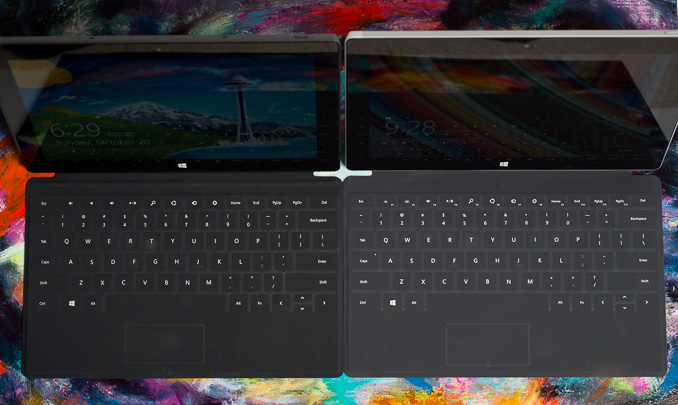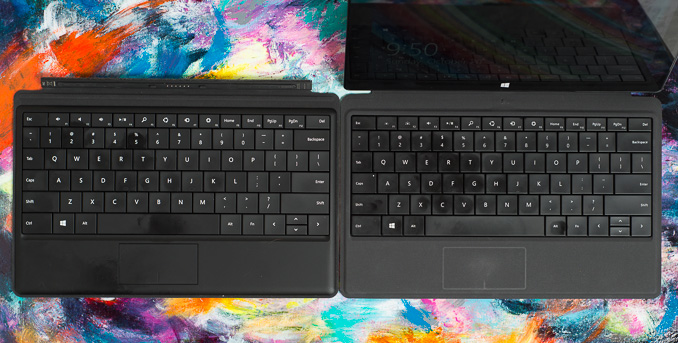Microsoft Surface 2 Review
by Anand Lal Shimpi on October 21, 2013 12:00 AM ESTThe New Touch/Type Covers
When I was first introduced to the folks who built Surface I was told about the three non-negotiable parts of its design: the tablet, the kickstand and the cover. While most tablet covers end up being protective accessories, the first party covers for Surface are an integral part of the overall experience.
Microsoft offers two cover options: the touch cover and the type cover. Both integrate full qwerty keyboards into a display cover that attached magnetically, but they differ in keyboard type. As its name implies, the touch cover integrates a pressure sensitive keyboard with no moving parts. By comparison, the type cover uses keys that physically move. Neither accessory is included with any Surface device and will set you back $119 for the touch cover and $129 for the type cover. They are expensive, but absolutely worth it if you’re going to do any sort of typing on your Surface.

Old (left) and new (right) touch covers
With the second generation of Surfaces, Microsoft improved both covers. They both get marginally thinner and backlit keys. The backlight effect is great, although there are only three keyboard backlight brightness levels.
The touch cover sees the biggest improvement as Microsoft moved from having only 80 pressure sensors in the previous design to 1092 sensors. The result is an incredible increase in accuracy. I find that I can type a lot lighter on the new touch cover and still have my keystrokes recognized. I also make far fewer mistakes on the new touch cover. While I felt that the initial touch cover was usable, this one is almost good enough to be a physical keyboard replacement.
| 2nd Generation Touch/Type Cover Thickness | ||||||||||
| Touch Cover | Type Cover | |||||||||
| 1st gen | 3.35 mm | 5.7 mm | ||||||||
| 2nd gen | 2.91 mm | 5.22 mm | ||||||||
| iPad 4 Smart Cover | 2.2 mm | |||||||||
Despite the tremendous improvement in accuracy on the new touch cover, I still prefer the type cover. I wrote long segments of this review on the new touch cover, but I had a much better time doing so on the type cover. Microsoft has reduced thickness on the new type cover, in part by reducing key travel. I’m happy to say that the reduction in key travel isn’t noticeable, and I’m able to type just as quickly and as comfortably as I could with the first gen type cover. The difference in thickness between the two is very small (~2.3mm) and you get a much more usable keyboard out of the type cover.

Old (left) and new (right) type covers
The new type cover ditches the clickpad in favor of a pressure sensitive trackpad. I’m a bit happier with the new trackpad but it’s still largely a pain to use for anything other than basic mousing. Two finger scrolling works ok, but any click and drag use is seriously frustrating thanks to the small size of the unit and no physical buttons. Thankfully there’s a 10.6-inch touchscreen a few inches away from you that works a lot better.
The new type cover ditches the felt backing of the previous model in favor of a soft touch plastic. Type covers are also now available in four colors (purple, pink, blue and black).
Remember that both of these covers make a physical connection to Surface, both to stay attached to the device as well as to transmit data. There’s no chance of running into spectrum crowding issues like you would with a 2.4GHz wireless keyboard, these keyboards are as good as any other wired device. The covers make a very strong magnetic connection to the device. The connection is strong enough to withstand picking up even a Surface Pro 2 by the attached cover and lightly swing it back and forth without the two separating. This is of course predicated on you properly attaching the cover to the tablet, but the strong magnets do a fairly good job of lining up and doing that as well.
The only issue I had with the new covers is that sometimes the trackpad would stop working after coming out of sleep. The keyboard worked fine, but the trackpad would just disappear. The only solution is to disconnect/reconnect the cover, which fixed it every time. I informed Microsoft about the issue, it’s something they’re aware of internally and plan to issue an update to fix.










139 Comments
View All Comments
ancientarcher - Monday, October 21, 2013 - link
This is a great improvement over the original Surface. The huge increase on the GPU front obviously made it possible for MS to offer the higher resolution screen and along with a better CPU made it a lot smoother to use.The king of tablets - yes. But then, no one talks about how ios is incompatible with OSX! It's only with MS that people expect 100/100 every time. Only if Windows RT had been compatible with the Windows Phone ecosystem. Then there would not be so much noise about the app ecosystem.
I am beginning to think how good a device this will be in a year or so, particularly if MS manages to merge the Windows Phone ecosystem with this (after all both run on ARM so should be theoretically possible). And yes, slightly lighter with better battery life needed. With a few more apps, this will be the perfect device.
kyuu - Monday, October 21, 2013 - link
Hmm, let's see:iPad 4 - 9.51" H, 7.31" W, .37" D
Surface 2 - 10.81" H, 6.79" W, .35" D
Surface 2 is thinner. It's longer but less wide due to the larger screen and 16:9 aspect ratio, which is better for pretty much everything except using it as an ereader. I don't see how it's "big and unwieldly" yet the iPad is magical. And then...
iPad 4 - 1.44 lbs.
Surafce 2 - 1.45 lbs.
I guess that extra .01 lbs. is all you need to make the difference between magical and heavy? Also I suppose you missed the part where Anand noted that, due to the weight distribution, the Surface 2 actually feels lighter in-hand.
Add in the fit & finish, the kickstand, and the facts that you have an actual honest-to-god USB port (3.0 no less!), a mini-HDMI out, and a much more fully featured OS with WinRT 8.1 than iOS will ever be, and I really can't see how the Surface 2 loses a value or specs comparison unless you're married to the iOS ecosystem.
cheshirster - Monday, October 21, 2013 - link
Another half-assed review of MS product.What about multitasking, storage options, external displays, browser capabilities (flash for example, on-site video playback), speakers, skyping comparison?
Why are those google services are so special so that one must care about them?
Steinegal - Monday, October 21, 2013 - link
Agree, you can still access Google services in your browser if you need it. You also get so many possibilities to connect any device you want through the USB port, like printers, scanners, mouse, keyboard, game controllers cameras etc. You also have a powerful multiuser environment something every android tablet that has a half assed implementation of gets a big plus for. For me it's the multitasking that seals the deal, my iPad is mostly used for Facebook, browsing and YouTube/Netflix, and the surface can do all of those at the same time. No more swapping app to reply to a message in Facebook, no more stopping the video to do a quick search for information. I might miss out on a few great apps, but mostly it's just games and I'm quite tired of all those pay2win games that seems to populate the appstores now.Gigaplex - Monday, October 21, 2013 - link
Multitasking? The software doesn't really do a good job of supporting that.Daniel Egger - Monday, October 21, 2013 - link
I have to disagree. While I don't give a rats ass about multitasking in a tablet (or phone) because the screen only allows modal operation anyway it works reasonably well even on the old RT. Almost too well because you'll only notice two Flash videos playing at the same time when the audio clashes.kyuu - Monday, October 21, 2013 - link
I have to agree. There's too much focusing on comparing it 1-to-1 to an iPad or Google tab and Anand seems to miss or gloss over a lot of the the functionality.1) Mentions the multitasking only in passing.
2) No mention of connecting accessories through the USB port, including external storage.
3) No mention of external display support, where you can actually EXTEND the display rather than simply mirroring it.
4) No mention of how the browser handles flash or works to bring up websites for Twitter or all those Google services that he complains are missing in the app store.
5) Not Surface 2 specific, but the quality of the speakers should be noted.
cheshirster - Monday, October 21, 2013 - link
What are the strong points of bringing in Bay Trail and "full" windows? Why we should even care? What exactly that "full" means in 10.6 inch tablet ?Qwertilot - Monday, October 21, 2013 - link
Its a good question actually :) Even if MS did put an atom into these, they may well backport RT rather than full 8.1.They rather badly need to drive the touch based eco system before these devices can make proper sense.
Gigaplex - Monday, October 21, 2013 - link
3rd party desktop applications, so you can actually use the device while you wait for useful Store apps to become available.